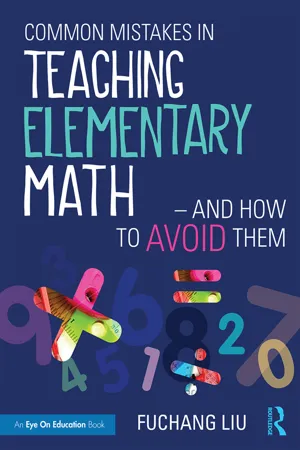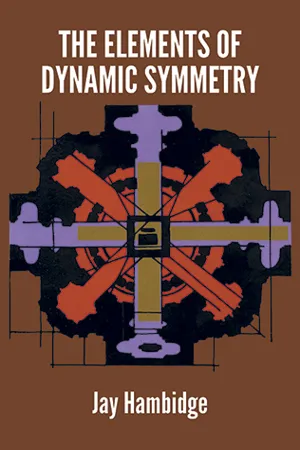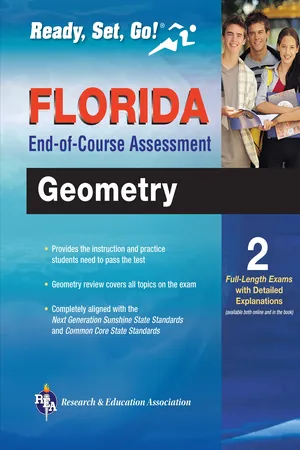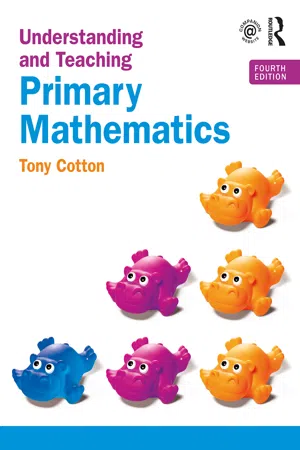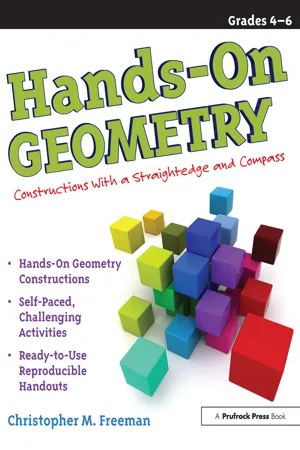Mathematics
Rectangle
A rectangle is a four-sided polygon with opposite sides that are equal in length and four right angles. It is a special case of a parallelogram where all angles are right angles. The area of a rectangle is calculated by multiplying its length by its width.
Written by Perlego with AI-assistance
Related key terms
7 Key excerpts on "Rectangle"
- Sandra Rush(Author)
- 2013(Publication Date)
- Research & Education Association(Publisher)
supplementary angles.Rhombus
If we add the condition that all four sides of a parallelogram are equal, then we have a rhombus. So a rhombus has all of the properties of a parallelogram plus the sides are equal.Thus, in the above figure of the rhombus, PQ – QR – RS – SP – s, and the perimeter can be written asLikewise, the area of the rhombus iswhere any of the sides can be used as the base, and the height drawn to each side is the same. The diagonals of a rhombus bisect each other (as they did for the parallelogram), but now they also are perpendicular to each other.Rectangle
If, instead of saying the four sides of the parallelogram are equal, we say that the four angles are equal, we have a Rectangle, which is a parallelogram with four equal angles.Thus, in the figure of the Rectangle above, and since the angles of a quadrilateral add up to 360°, each of the four angles is 90°, or a right angle.The opposite sides are equal, as in a parallelogram, but not all sides are equal (as they were in the rhombus). The perimeter is written as usual asBecause all the angles are right angles, all sides l (length) are perpendicular to sides w (width), so they take the place of the base and height, and the area of the Rectangle isIf we think of tiling a floor in a straight line, we get an idea of why area is length times width. Suppose we wanted to tile a room that is 12 feet by 10 feet in 1-foot tiles. If you count the number of tiles needed, it would be 12 rows of 10 tiles (or 10 rows of 12 tiles), and that total is 120 tiles, each 1 foot square, which is the area of the floor: 120 square feet.- Fuchang Liu(Author)
- 2017(Publication Date)
- Routledge(Publisher)
The confusion is even worse if the layout and the lengths of the two pairs of sides are combined. Suppose it was stipulated that the longer side was length and the shorter side was width, and further suppose it was stipulated that the side from left to right was the width and the side from top to bottom is the length. Then how can we deal with a Rectangle whose longer side is from left to right, such as a television screen? Now children can really get confused.Simply put, the width of a Rectangle can run from left to right or from top to bottom or whatever direction if the figure is tilted—and the same is true for length .“A Rectangle Has Two Longer Sides and Two Shorter Sides”
In comparing a Rectangle to a square, Jane said this to her children: “A square has four congruent sides but a Rectangle has two longer sides and two shorter sides.” Before we take on this issue, let’s start with the defining features of each shape, as listed in the following Math in Action boxes.Math in Action: Defining Features of a Rectangle- Quadrilateral (four-sided);
- opposite sides parallel to each other;
- opposite sides congruent (equal in length); and
- all four angles are right angles.
Math in Action: Defining Features of a Square- Quadrilateral;
- opposite sides parallel to each other;
- all four sides congruent ; and
- all four angles are right angles.
Here, all the features for both shapes are identical except for one: For a Rectangle, the opposite sides are congruent whereas for a square, all four sides are congruent (this feature is italicized in the boxes).Let’s take up the Rectangle first. For any Rectangle, each pair of opposite sides are congruent. There are two possibilities concerning the relationship between these two pairs: One possibility is that one pair is longer than the other, and the other possibility is one pair is as long as the other. Since the defining features of a Rectangle don’t say anything concerning the relationship between these two pairs of sides, we have to assume that whether one pair of sides is longer than the other pair, or one pair is as long as the other, is irrelevant to whether a shape is a Rectangle or not.- eBook - ePub
- Mel Friedman(Author)
- 2012(Publication Date)
- Research & Education Association(Publisher)
vertex).PARALLELOGRAMSA parallelogram is a quadrilateral whose opposite sides are parallel.Two angles that have their vertices at the endpoints of the same side of a parallelogram are called consecutive angles. So A is consecutive to B; B is consecutive to C; C is consecutive to D; and D is consecutive to A.The perpendicular segment connecting any point of a line containing one side of a parallelogram to the line containing the opposite side of the parallelogram is called the altitude of the parallelogram.A diagonal of a polygon is a line segment joining any two nonconsecutive vertices. The area of a parallelogram is given by the formula A = bh, where b is the base and h is the height drawn perpendicular to that base. Note that the height is the same as the altitude of the parallelogram.Example:The area of the parallelogram below is:A = bhA = (10)(3)A = 30RectangleSA Rectangle is a parallelogram with right angles.• The diagonals of a Rectangle are equal, .• If the diagonals of a parallelogram are equal, the parallelogram is a Rectangle.• If a quadrilateral has four right angles, then it is a Rectangle.• The area of a Rectangle is given by the formula A = lw, where l is the length and w is the width.Example:The area of the Rectangle below is:A = lwA = (4)(9)A = 36RHOMBIA rhombus (plural: rhombi) is a parallelogram that has two adjacent sides that are equal.• All sides of a rhombus are equal.• The diagonals of a rhombus are perpendicular bisectors of each other.• The area of a rhombus can be found by the formula where d1 and d2 are the diagonals.ABCD is a rhombus. AC = 4 and BD = 7. The area of the rhombus is - eBook - ePub
- Jay Hambidge(Author)
- 2012(Publication Date)
- Dover Publications(Publisher)
perpendicular; the side opposite the right angle is called the hypotenuse.Any of the angular points of a triangle may be called the vertex. If one of the sides of a triangle has been called the base, the angular point opposite that side is usually called the vertex.A rhombus is a quadrilateral that has all its sides equal.A square is a quadrilateral that has all its sides equal, and all its angles right angles.A parallelogram is a quadrilateral whose opposite sides are parallel.A Rectangle is a quadrilateral whose opposite sides are parallel, and whose angles are right angles.A trapezium is a quadrilateral that has two sides parallel.A diagonal of a quadrilateral is a straight line joining any two opposite corners.BOOK II.
Any rectangular parallelogram is said to be contained by the two straight lines containing the right angle.And in any parallelogrammic area let any one whatever of the parallelograms about its diameter with the two complements be called a gnomon. - Rebecca Dayton(Author)
- 2013(Publication Date)
- Research & Education Association(Publisher)
Chapter 3Quadrilaterals
Your Goals for Chapter 3
1. You should know the properties of quadrilaterals and use them to solve problems. 2. You should be able to use coordinate geometry to prove the properties and theorems of special quadrilaterals.Standards
The following standards are assessed on Florida’s Geometry End-of-Course exam either directly or indirectly:MA.912.G.3.1: (Moderate) Describe, classify, and compare relationships among quadrilaterals including the square, Rectangle, rhombus, parallelogram, trapezoid, and kite. MA.912.G.3.2: (Moderate) Compare and contrast special quadrilaterals on the basis of their properties. MA.912.G.3.3: (High) Use coordinate geometry to prove properties of congruent, regular, and similar quadrilaterals. MA.912.G.3.4: (High) Prove theorems involving quadrilaterals. Special Quadrilaterals
A quadrilateral is a polygon with four sides. There are several types of special quadrilaterals.The above figure looks like a tree diagram. It can be thought of as the “Quadrilateral Family Tree” because it shows the relationships among the different types of special quadrilaterals. Example: True or False. a. A square is a type of Rectangle. b. A parallelogram is a type of rhombus. c. A rhombus is a type of kite. d. A parallelogram is a type of trapezoid. e. A Rectangle is a type of rhombus. a. True: Although a square does have more specific properties than a Rectangle, it does maintain all of the properties of a Rectangle. Therefore, a square is a Rectangle. b. False: A rhombus must have four congruent sides and a parallelogram does not. Therefore, a parallelogram cannot be a type of rhombus. (However, a rhombus is a type of parallelogram.) c. False: A kite has two separate pairs of congruent adjacent sides rather than the four congruent sides of a rhombus. d. False: A trapezoid can have only one pair of parallel sides. A parallelogram must have two pairs of parallel sides. e. False: A Rectangle does not have four congruent sides, therefore, it cannot be a rhombus.- eBook - ePub
- Tony Cotton(Author)
- 2020(Publication Date)
- Routledge(Publisher)
oblong is a Rectangle that isn’t a square. Parallelogram A quadrilateral with opposite sides parallel Trapezium A quadrilateral with only one pair of parallel sides Kite A quadrilateral with adjacent sides (i.e. sides that are joined at a point) of equal lengthPortfolio task 9.3
Try this activity – the folding helps you understand ideas of symmetry, and the surprises when you unfold the shape support you in noticing the properties of the shapes. Children find it motivating too as it develops their skills of visualisation because they have to try to visualise the shape that will emerge when they unfold the paper.Take a piece of A4 paper and make one fold anywhere. You do not have to fold it in half. Make a cut so that you form two shapes out of the piece of paper. Sketch the two shapes that you have made and name them. Can you find ways to fold and cut the paper so that you make a square, a rhombus , a Rectangle, a parallelogram , a trapezium and a kite?Three-dimensional shapes can also be classified in several ways.Prismsandpyramidsare sometimes confused. I remember a 14-year-old pupil of mine describing the difference as, ‘A prism is where you find naughty people and a pyramid is where you find dead people’. The actual difference is to do with the cross-section. You can slice a prism at any point, parallel to the face at the end, and you will always get the same cross-section, whereas if you slice a pyramid you will get different sizes of the same shape.Two prisms you might recognise are acubeand a cuboid. The most common 3D shapes are shown as follows. One way of classifying 3D shapes is by the numbers offaces,edgesand vertices (singularvertex - eBook - ePub
Hands-On Geometry
Constructions With a Straightedge and Compass (Grades 4-6)
- Christopher M. Freeman(Author)
- 2021(Publication Date)
- Routledge(Publisher)
Opposite sides of a Rectangle are equal in length. This property provides a quicker way to construct a Rectangle. First construct one right angle, and then make all of the sides the correct lengths. Your construction will look like the drawing on the right.- Erect a line through D perpendicular to Label the line, m.
- Open your compass radius to the length QP Make an arc with center D, above D. Label the point where the arc crosses line m, A.
- Keeping the same radius QP, make an arc with center C, above C.
- Change the radius to DC, and make an arc with center A, to the right of A.
- Label the point where these arcs cross, B.
- Draw and . ABCD is a Rectangle, because its opposite sides are equal and it has a right angle.
In what two ways are the diagonals of a Rectangle related to each other? ____________________________________________________________________________ ____________________________________________________________________________Name____________________________________________________ Date______________________Lesson 4.5Construct a Square When Given Its Side
A square is a special type of Rectangle in which all four sides are the same length, In Lesson 2.5 , you constructed a square given its diagonal. Now, use what you have learned about Rectangles to construct a square given its side. Build your square on side below Show all of the construction arcs you need—don't erase them!Draw the diagonals of square ABCD.- a. Describe each step of your construction.
- 1. Erect a line through D perpendicular to . Label the line, m.
- 2. ___________________________________________________________
- 3. ___________________________________________________________
- 4. ___________________________________________________________
- 5. ___________________________________________________________
- 6. ___________________________________________________________
- 7. ___________________________________________________________
- b. In what four ways are the diagonals of a square related to each other (or to the angles of the square)?
Index pages curate the most relevant extracts from our library of academic textbooks. They’ve been created using an in-house natural language model (NLM), each adding context and meaning to key research topics.

